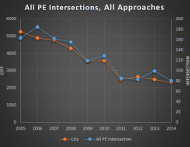11/3/2015
Red Light Cameras Fail To Reduce Accidents In Tucson, ArizonaAccident analysis shows no safety benefit to photo enforcement in Tucson, Arizona.

As voters in Tucson, Arizona head to the polls today to decide the fate of automated ticketing machines, an analysis shows the use of red light cameras since 2007 has failed to reduce accidents. Peoria resident Ryan Denke produced the report using the Arizona Department of Transportation's database of traffic accidents covering the years 2005 through 2014.
Denke observed that the number of crashes statewide rose or fell in sync with the number of miles driven in every year but 2005. This makes sense since the more time cars spend in traffic, the greater the statistical chance that they will be involved in an accident. In Tucson, Denke calculated a 92 percent correlation between miles driven and accidents.
At the intersection of Grant Road and Tanque Verde Road, the total number of accidents almost exactly tracks the citywide crash trends. The only difference is that the photo enforced intersection saw the number of injury collisions climb after cameras were activated in 2007. The results were similar at each of the other photo enforced locations.
"A comparison of trends between the intersection and the city shows a general correlation," Denke explained for the intersection of Nogales Highway and Valencia Road. "There is no significant difference between the city wide trend and this intersection, indicating that this camera has had very little impact on crashes."
This finding runs counter to the claims of Tucson officials who have insisted that accidents have plunged thanks to the use of automated ticketing. An alternative explanation is that crashes did decline when the housing market bubble burst in 2007 and the US economy plunged into recession. This resulted in a significant drop in miles driven, especially in Arizona.
"By using a simplistic approach to crash data that did not account for miles driven or other factors, city officials have mistakenly attributed reductions in crashes to photo ticketing equipment," Denke explained. "This limited analysis has lead Tucson to erroneously celebrate the success of their photo ticketing system rather than scrutinizing the performance and the results."
Denke found that state records showed only 6.7 percent of crashes were caused by exceeding the posted speed limit or running a stop light, as compared to 27.4 percent of accidents being caused by drivers who were distracted or using a cell phone. Denke argues these data show that red light cameras and speed cameras could never have more than a marginal effect on accident rates.
A copy of the Denke analysis is available in a 1.4mb PDF file at the source link


